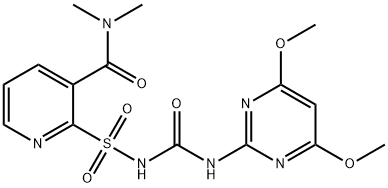
Service hotline +86 27-5952-7208
Herbicides
HerbicidesContact us

Nicosulfuron 95TC
| Nicosulfuron Basic information |
| Product Name: | Nicosulfuron |
| Synonyms: | ACCENT;ACCENT (TM);1-(4,6-Dimethoxy-2-pyrimidinyl)-3-[3-(dimethylcarbamoyl)-2-pyridylsulfonyl]urea, 2-[(4,6-Dimethoxypyrimidin-2-ylcarbamoyl)sulfamoyl]-N,N-dimethylnicotinamide;Accetn;MU 495;Nisshin;1-(4,6-Dimethoxy-2-pyrimidinyl)-3-[3-(dimethylcarbamoyl)-2-pyridylsulfonyl]urea;Accent【pesticide】 |
| CAS: | 111991-09-4 |
| MF: | C15H18N6O6S |
| MW: | 410.4 |
| EINECS: | 244-666-2 |
| Product Categories: | Agro-Products;Amines;Herbicide;Heterocycles;Sulfur & Selenium Compounds |
| Mol File: | 111991-09-4.mol |
 | |
| Nicosulfuron Chemical Properties |
| Melting point | 141-144°C |
| density | 1.4126 (rough estimate) |
| refractive index | 1.7000 (estimate) |
| storage temp. | Sealed in dry,Room Temperature |
| pka | pKa (25°): 4.6 |
| form | neat |
| InChIKey | RTCOGUMHFFWOJV-UHFFFAOYSA-N |
| CAS DataBase Reference | 111991-09-4(CAS DataBase Reference) |
| EPA Substance Registry System | Nicosulfuron (111991-09-4) |
| Safety Information |
| Hazard Codes | Xi,N |
| Risk Statements | 36/38-50/53 |
| Safety Statements | 24/25-26-61 |
| RIDADR | UN 3077 9 / PGIII |
| WGK Germany | 1 |
| RTECS | US4615000 |
| HS Code | 29350090 |
| Hazardous Substances Data | 111991-09-4(Hazardous Substances Data) |
| Nicosulfuron Usage And Synthesis |
| Description | Nicosulfuron is a kind of herbicides belonging to the sulfonylurea family. It is a broad-spectrum herbicide that can controls many kinds of maize weeds including both annual weeds and perennial weed including Johnsongrass, quackgrass, foxtails, shattercane, panicums, barnyardgrass, sandbur, pigweed and morningglory. It is a systemic selective herbicide, being effective in killing plants near the maize. This selectivity is achieved through maize’s capability of metabolizing Nicosulfuron into harmless compound. Its mechanism of action is through inhibiting the enzyme acetolactate synthase (ALS) of the weeds, blocking the synthesis of amino acids such as valine and isoleucine, and finally inhibiting the protein synthesis and causing death of weeds. |
| References | http://www.agchemaccess.com/Nicosulfuron http://pmep.cce.cornell.edu/profiles/extoxnet/metiram-propoxur/nicosulfuron-ext.html |
| Chemical Properties | White Solid |
| Chemical Properties | White crystalline solid or powder. Phenolic odor. |
| Uses | Herbicide. |
| Uses | Post-emergence sulfonylurea herbicide |
| Definition | ChEBI: A N-sulfonylurea that is 2-(carbamoylsulfamoyl)-N,N-dimethylpyridine-3-carboxamide substituted by a 4,6-dimethoxypyrimidin-2-yl group at the amino nitrogen. |
| Agricultural Uses | Herbicide: Used as a post-emergence herbicide to control a variety of weeds on field corn and popcorn crops. Some formulations may be U.S. EPA restricted Use Pesticides (RUP). Approved for use in EU countries. |
| Trade name | ACCENT®; BASIS®; CELEBRITY®; CHALLENGER®; DASUL®; DPX 79406® Herbicide (with Rimsulfuron); DPX-V9636®; GHIBLI®; LAMA®; MATRIX® Herbicide (with Rimsulfuron); MILAGRO®; MISTRAL®; MOTIVEL®; NISSHIN®; SAMSON®; STEADFAST® (nicosulfuron + rimsulfuron) |
| Potential Exposure | Nicosulfuron is a sulfonylurea postemergence herbicide used to control a variety of weeds on field corn and popcorn crops. Some formulations may be registered as United States Restricted Use Pesticides (RUP) |
| Metabolic pathway | In the four systems investigated, the primary degradation pathway is to yield pyridine sulfonamide and 4,6-dimethoxy-2-aminopyrimidine. The plant and its microsomal system include the hydroxylation pathway at the 4-position of the pyrimidine ring, resulting in hydrolysis products by the cleavage of the sulfonylurea linkage. In mammals, contraction or rearrangement of the sulfonylurea linkage for nicosulfuron and N- demethylated nicosulfuron yields two unique products which have the N-pyridyl-N-pyrimidyl urea moiety and result in the uracil metabolite. |
| Shipping | UN3077 or UN3082 Environmentally hazardous substances, liquid or solid, n.o.s., Hazard Class: 9; Labels: 9-Miscellaneous hazardous material, Technical Name Required. |
| Incompatibilities | Slowly hydrolyzes in water, releasing ammonia and forming acetate salts. Decomposed >165℃. |
| Waste Disposal | It is the responsibility of chemical waste generators to determine the toxicity and physical properties and of a discarded chemical and to properly identify its classification and certification as a hazardous waste and to determine the disposal method. United States Environmental Protection Agency guidelines for the classification determination are listed in 40 CFR Parts 261.3. Additionally, waste generators must consult and follow all regional, national, state and local hazardous waste laws to ensure complete and accurate classification and disposal methods. |
| Nicosulfuron Preparation Products And Raw materials |
| Raw materials | Dichloromethane-->Thionyl chloride-->1,4-Dioxane-->Chlorine-->Dimethyl sulfoxide-->Trifluoroacetic acid-->Formamide-->Potassium sulfate-->tert-Butylamine-->Nicotinamide-->Benzyl mercaptan-->Butylsulfonamide-->METHYL 2-CHLORONICOTINATE |
Preparation Products | 2-Aminosulfonyl-N,N-dimethylnicotinamide |
previous_page:Atrazine
next_page:Terbuthylazine